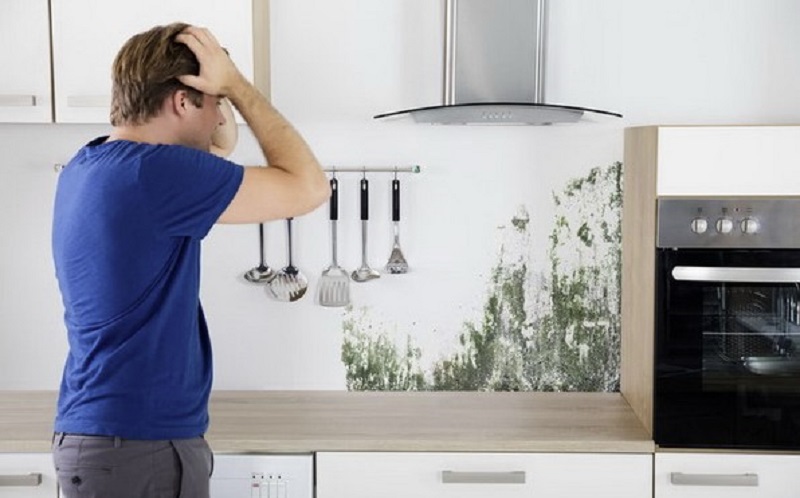Mold can grow in hidden areas such as wall cavities and behind pipes. Sometimes the growth is a result of water problems like leaks and flooding.
But even when you keep your home dry and clean, you may still see black mold in the ceiling and other surfaces. Perhaps a challenging concept to grasp about mold contamination in your home is you may not even see it.

Sometimes mold can grow in your home, and there may be no visible growth on the walls or surfaces. You may not even notice that something is wrong. Luckily, even invisible mold leaves behind some clues.-
One way to find hidden mold in your house is to spray bleach on the affected areas. If the surface changes color, it is an indication that the fungus is present. An in-home testing kit can also help you determine mold growth. Fuzzy appearances or stains on walls or furniture indicate the presence of mold too.
Contents
How can you tell if mold is in the walls?
Here is how to test for mold inside walls and other surfaces in your home.
1. Borescope
A borescope is a small camera on a long flexible tube. It is a useful tool that works as a mold detector to help you find the fungus in hidden areas or spaces between walls.
Here is how to use a borescope to detect mold:
- Make a small hole into the wall affected by moisture or water leaks.
- Insert the fiber optic cable end of the borescope through the hole.
- Check the monitor for any signs of mold.
If mold is present, the color and size of the fungus will change on the borescope monitor. In that case, you will either have to clean the area or call a professional to get rid of it.
You can also use a borescope to check for mold in air ducts.
2. Diluted bleach
You can do a quick test for black mold by using diluted bleach. Follow the steps below:
- Mix one-part bleach in 16 parts water.
- Dip a swab in the solution.
- Dab the swab on the wall.
If the area lightens quickly, it could be mold. However, call a professional for a second opinion.
3. Mold test kit
If you notice signs of mold in your house, you can use a mold testing kit. Mold testing kits are available online from $5. However, we recommend Mold Armor FG500 strips for the best results.
Use them by collecting at least three samples from different surfaces in your home that you think are affected by the fungus. All in-home mold testing kits come equipped with instruments and instructions. Ensure to follow the directions of use.
In some cases, you will have to send the samples to the company to do an analysis. Depending on the kit, it may cost you to get the results.
Note that the kits are useful for invisible mold. You can also use them to test for mold in the air. But if you see visible signs of the fungus in your home, it will be unnecessary to use them, and the best solution is to figure out how to eliminate the mold.
4. Call a professional
Mold inspectors have the most effective tools and instruments for detecting the fungus in all areas. They will help you identify the type of mold affecting your home and take you through the process of removing it.
Before hiring the professional, ensure they have the right licenses that allow them to run their operations.
5. Inspect surfaces for visible mold
You can inspect different surfaces in your home to identify visible mold. The fungus has a hazy appearance and can look like a stain. Its color can be black, green, brown, or white. Mold also feels like sand, velvet, or cotton and gives off a musty odor.
When inspecting for mold, check around areas with water damage and moisture. That includes paint bubbling or stains on walls or pipes. Other surfaces to consider include:
- Basements
- Utility rooms
- Enclosed spaces
- Windows
- Shower curtains
- Ceiling corners
- Air ducts and vents
- Roof leaks
Ideally, check any areas with lots of condensation and moisture. If your home is not well ventilated, it can be a breeding ground for mold. You also need to do a thorough inspection of your entire house, especially if it has ever flooded.
How to know if mold is making you sick?
It is a health risk to inhale any species of mold. The tiny spores can cause many problems, especially in people suffering from allergies, respiratory problems, or compromised immune systems.
According to Mayo Clinic, you will know that mold is making you sick if you exhibit the following symptoms:
- Headache
- Sore throat
- Coughing
- Runny nose
- Sneezing
- Fatigue
- Watery eyes
If you have an impaired immune system, you may suffer from a severe infection.
Once you notice any of the above symptoms, consider professional mold testing to identify its location and get rid of it.
How to prevent mold growth
You can prevent mold growth in your home in different ways:
- Maintain a humidity level of between 30% and 50% in your home. Ensure to open all windows when it is not humid to allow the circulation of fresh air. Alternatively, use a dehumidifier.
- Avoid using carpets in your bathroom or basement since they trap moisture under the surface and attract mold.
- Use exhaust pipes when cooking to trap water vapor and in the bathroom to reduce condensation when showering.
- Clean and dry the shower curtain after taking a bath.
- Fix any leaking pipes and roofs.
Understand that moist and damp environments are the breeding grounds for mold. Ensure to make your home dry to avoid the harmful health effects caused by the fungus.
Conclusion
As a homeowner, you must know how to test for mold in the house to avoid the harmful health effects caused by the fungus. You can use a borescope, mold testing kit, or bleach to test for the presence of hidden mold in your home. Alternatively, call a professional to help you find the fungus in hidden spaces.
If you see visible mold in your home, consider eliminating it immediately. But to avoid its growth, ensure to keep your home dry by getting rid of any source that causes condensation or moisture.
Read Also
